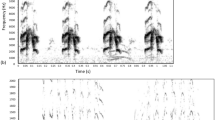Abstract
The ability to recognize and remember individual identities for long periods of time has important implications for the evolution of animal social behaviour, particularly complex interactions such as cooperation or mate choice1,2,3,4,5,6,7. Despite this importance, there is only a single example of long-term individual recognition in nature, the 8-month retention of neighbour's song among male hooded warblers, Wilsonia citrina7, and there is none for a non-human mammal. Associations between individuals spanning years, which are especially prevalent in carnivores8, primates9 and seabirds10, and evidence of mate fidelity11,12 provide indirect support for the ability of long-term recognition. In many of these instances, however, individuals do not separate for extended periods, and thus long-term recognition, although often assumed, may be both unnecessary and nonexistent. Furthermore, site fidelity rather than individual recognition may explain many instances of mate fidelity10. Here I show that mother–offspring pairs of a migratory otariid pinniped—the northern fur seal (Callorhinus ursinus)—not only have the ability to recognize each other's vocalizations during the course of a breeding season, but are also able to retain these memories for at least 4 years.
This is a preview of subscription content, access via your institution
Access options
Subscribe to this journal
Receive 51 print issues and online access
$199.00 per year
only $3.90 per issue
Buy this article
- Purchase on Springer Link
- Instant access to full article PDF
Prices may be subject to local taxes which are calculated during checkout
Similar content being viewed by others
References
Sherman, P. W., Reeve, H. K. & Pfennig, D. W. in Behavioural Ecology: An Evolutionary Approach, Fourth Edition (eds Krebs, J. R. & Davis, N. B.) 69– 96 (Blackwell, Oxon, 1997).
Falls, B. J. in Acoustic Communication in Birds, Volume 2: Song Learning and its Consequences (eds Kroodsma, D. E. & Miller, E. H.) 237– 278 (Academic, New York, 1982).
Stoddard, P. K. in Ecology and Evolution of Acoustic Communication in Birds (eds Kroodsma, D. E. & Miller, E. H.) 356–374 (Cornell Univ. Press, Ithaca, 1996).
Beecher, M. D. in Kin Recognition (ed. Hepper, P. G.) 94–124 (Cambridge Univ. Press, Cambridge, 1991).
Colgan, P. Comparative Social Recognition (Wiley, New York, 1983 ).
Mateo, J. M. & Johnston, R. E. Retention of social recognition after hibernation in Belding's ground squirrels. Animal Behaviour 59, 491–499 ( 2000).
Godard, R. Long-term memory of individual neighbours in a migratory songbird. Nature 350, 228–229 ( 1991).
Waser, P. M. in Carnivore Behavior, Ecology, and Evolution,Volume 2 (ed. Gittleman, J. L.) 267–295 (Cornell Univ. Press, Ithaca, 1996)
Smuts, B., Cheney, D., Seyfarth, R., Wrangham, R. & Struhsaker, T. (eds) Primate Societies (Univ. Chigago Press, Chicago, 1987).
Black, J. M. Partnership in Birds: The Study of Monogamy (Oxford Univ. Press, New York, 1996).
Amos, B., Twiss, S., Pomeroy, P. & Anderson, S. Evidence for mate fidelity in the gray seal. Science 268, 1897–1899 (1995).
Uy, J. A. C., Patricelli, G. L. & Borgia, G. Dynamic mate-searching tactic allows female satin bowerbirds Ptilonorhynchus violaceus to reduce searching. Proc. R. Soc. Lond. 267, 251–256 ( 2000).
Insley, S. J. Mother-offspring separation and acoustic stereotypy: A comparison of call morphology in two species of pinnipeds. Behaviour 120 , 103–122 (1992).
Insley, S. J. Mother-offspring vocal recognition in northern fur seals is mutual but asymmetrical. Animal Behaviour (in the press).
Gentry, R. L. Behavior and Ecology of the Northern Fur Seal (Princeton Univ. Press, Princeton, 1998).
Regan, T., Antonelis, G. & Kyota, M. Early migration of northern fur seal pups from St. Paul Island, Alaska. J. Mammal. 76, 1137– 1148 (1995).
Baker, J. D., Antonelis, G. A., Fowler, C. W. & York, A. E. Natal site fidelity in northern fur seals, Callorhinus ursinus. Animal Behaviour 50, 237–247 (1995).
Leger, D. W. & Didrichsons, I. A. An assessment of data pooling and some alternatives. Animal Behaviour 48, 823–832 (1994).
Acknowledgements
This research was supported by the National Science and Engineering Research Council of Canada, the National Marine Fisheries Service and the American Museum of Natural History. We thank G. Antonelis, T. Steeves and B. Robson for help in the field; and P. Marler, A. Harcourt, D. Owings, J. Dumbacher, L. Shapiro, K. Phillips, T. Porter and D. Boness for helpful discussions on the manuscript.
Author information
Authors and Affiliations
Rights and permissions
About this article
Cite this article
Insley, S. Long-term vocal recognition in the northern fur seal. Nature 406, 404–405 (2000). https://doi.org/10.1038/35019064
Received:
Accepted:
Issue Date:
DOI: https://doi.org/10.1038/35019064
This article is cited by
-
The potential for acoustic individual identification in mammals
Mammalian Biology (2022)
-
How visual system configuration can play a role in individual recognition: a visual modeling study
Animal Cognition (2022)
-
Equivalence classification, learning by exclusion, and long-term memory in pinnipeds: cognitive mechanisms demonstrated through research with subjects under human care and in the field
Animal Cognition (2022)
Comments
By submitting a comment you agree to abide by our Terms and Community Guidelines. If you find something abusive or that does not comply with our terms or guidelines please flag it as inappropriate.



